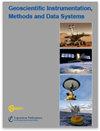Development of Internet-of-Things-Based Controlled-Source Ultra-Audio Frequency Electromagnetic Receiver
IF 2.3
4区 地球科学
Q3 GEOSCIENCES, MULTIDISCIPLINARY
引用次数: 0
Abstract
Abstract. Electromagnetic exploration, characterized by its low cost, wide applicability, and high operational efficiency, finds extensive applications in fields such as oil and gas exploration, mineral prospecting, and engineering geology. Traditional controlled-source electromagnetic detection methods are typically confined to operating frequencies below 250 kHz, resulting in insufficient detection accuracy for applications such as shallow and intermediate-depth exploration, thereby constraining their performance in high-resolution imaging. To address these challenges, we propose a controlled-source ultra-audio frequency electromagnetic receive system based on the Internet of Things (IoT). We investigate cascaded digital filtering and sampling techniques to extend the receiver's sampling rate range, thereby elevating the operating frequency of controlled-source electromagnetic acquisition from the conventional maximum of 250 kHz to 1 MHz. The receiver achieves a sampling rate of up to 2.5 MHz, comprising three magnetic field measurement channels and two electric field measurement channels. The instrument is compact, lightweight, capable of real-time data storage locally, and real-time data transmission to an upper computer. Additionally, IoT technology is introduced, leading to the design of a cloud-based real-time remote control and data acquisition scheme. Experimental results demonstrate the stability of the instrument, meeting the requirements of field exploration.开发基于物联网的可控源超音频电磁接收器
摘要。电磁探测具有成本低、适用性广、作业效率高等特点,在油气勘探、矿产勘探和工程地质等领域有着广泛的应用。传统的受控源电磁探测方法的工作频率通常限制在 250 kHz 以下,导致探测精度不足以满足浅层和中深层勘探等应用的需要,从而制约了其在高分辨率成像方面的性能。为了应对这些挑战,我们提出了一种基于物联网(IoT)的可控源超音频电磁接收系统。我们研究了级联数字滤波和采样技术,以扩展接收器的采样率范围,从而将可控源电磁采集的工作频率从传统的最高 250 kHz 提升到 1 MHz。接收器的采样率高达 2.5 MHz,包括三个磁场测量通道和两个电场测量通道。该仪器结构紧凑、重量轻,能够在本地实时存储数据,并将数据实时传输到上位机。此外,还引入了物联网技术,设计了基于云的实时远程控制和数据采集方案。实验结果表明,该仪器性能稳定,满足野外勘探的要求。
本文章由计算机程序翻译,如有差异,请以英文原文为准。
求助全文
约1分钟内获得全文
求助全文
来源期刊

Geoscientific Instrumentation Methods and Data Systems
GEOSCIENCES, MULTIDISCIPLINARYMETEOROLOGY-METEOROLOGY & ATMOSPHERIC SCIENCES
CiteScore
3.70
自引率
0.00%
发文量
23
审稿时长
37 weeks
期刊介绍:
Geoscientific Instrumentation, Methods and Data Systems (GI) is an open-access interdisciplinary electronic journal for swift publication of original articles and short communications in the area of geoscientific instruments. It covers three main areas: (i) atmospheric and geospace sciences, (ii) earth science, and (iii) ocean science. A unique feature of the journal is the emphasis on synergy between science and technology that facilitates advances in GI. These advances include but are not limited to the following:
concepts, design, and description of instrumentation and data systems;
retrieval techniques of scientific products from measurements;
calibration and data quality assessment;
uncertainty in measurements;
newly developed and planned research platforms and community instrumentation capabilities;
major national and international field campaigns and observational research programs;
new observational strategies to address societal needs in areas such as monitoring climate change and preventing natural disasters;
networking of instruments for enhancing high temporal and spatial resolution of observations.
GI has an innovative two-stage publication process involving the scientific discussion forum Geoscientific Instrumentation, Methods and Data Systems Discussions (GID), which has been designed to do the following:
foster scientific discussion;
maximize the effectiveness and transparency of scientific quality assurance;
enable rapid publication;
make scientific publications freely accessible.
 求助内容:
求助内容: 应助结果提醒方式:
应助结果提醒方式:


